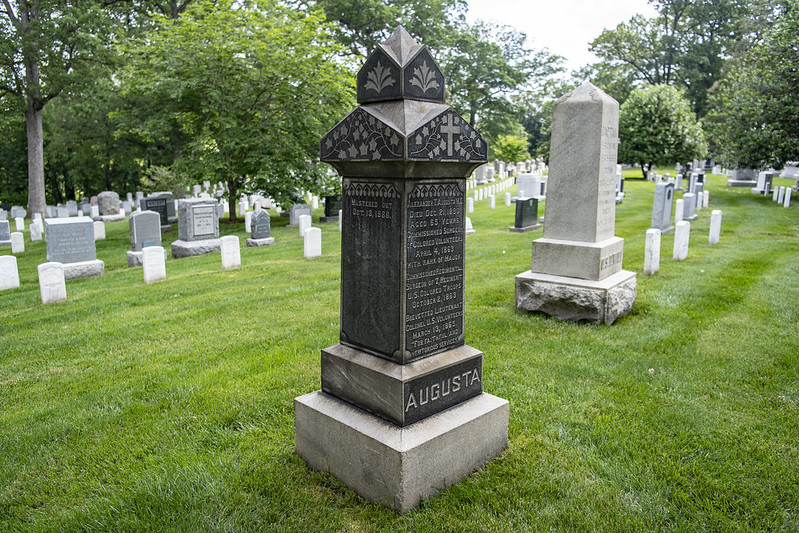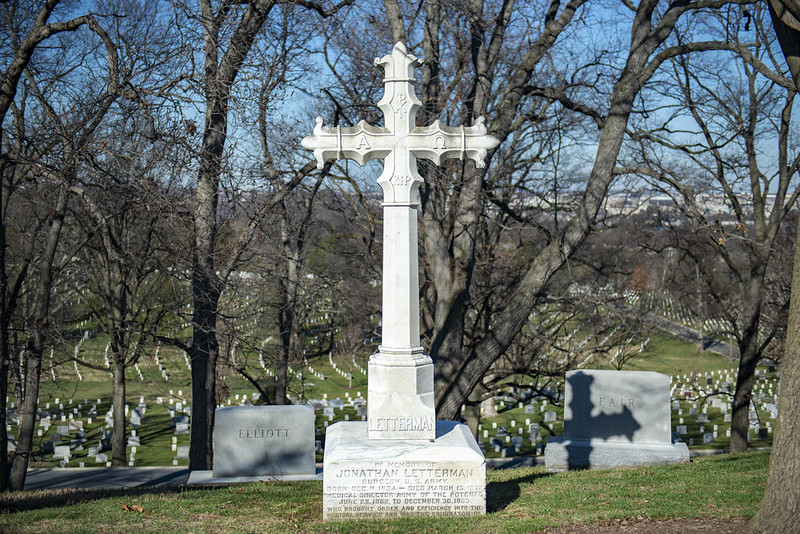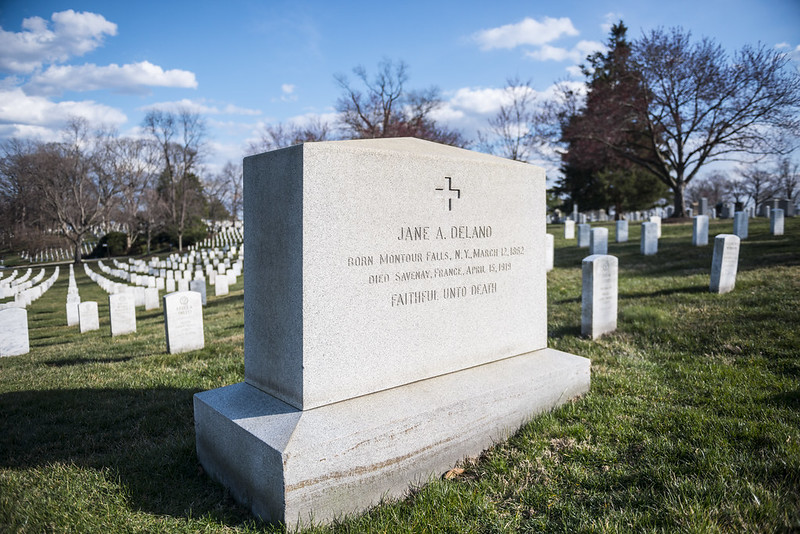
Doctors
Alexander T. Augusta, U.S. Army (1825-1890) — Augusta was the U.S. Army's first Black physician, as well as the United States' first Black hospital administrator (Freedman's Hospital, Washington, D.C.) and professor of medicine (Howard University). A graduate of Canada's Trinity Medical College, he was commissioned as a major during the Civil War, serving as regimental surgeon of the 7th Infantry of the U.S. Colored Troops. Promoted to brevet lieutenant colonel in 1865, Augusta became the highest-ranking Black officer of the Civil War. He went on to become one of the founding faculty members of the nearly all-white Howard University Medical Department. (Section 1, Grave 124-C)
Ollie Josephine Prescott Baird Bennett, U.S. Army (1874–1957) — After earning an M.D. from Boston University Medical School, Ollie Josephine Prescott Baird (later Baird Bennett, following her 1934 marriage) signed a contract with the Army Medical Corps in 1918. At the time, women physicians could serve with the Medical Corps only as contract surgeons—civilians who worked for the Army but were not in the Army, received lower salaries, no military benefits, and no formal rank or commission. Like many other women contract physicians during the World War I era, Baird served as an anesthetist. She supervised two operating rooms at Fort McClellan (Alabama) and trained women in the Army Nurse Corps, as well as Army enlisted men. She was also appointed to the War Industries Board as supervisor of health for more than 1,000 female employees. During the interwar years, Baird Bennett opened a private medical practice in Washington, D.C. In March 1943, she testified before Congress to support commissioning female physicians in the Army and Navy. The efforts of Baird Bennett and other advocates proved effective. On April 16, 1943, President Franklin D. Roosevelt signed the Sparkman-Johnson Bill, which formally allowed women to earn commissions in the Army and Navy Medical Corps. (Section 10, Grave 10938-LH)
Joel T. Boone, U.S. Navy (1889-1974) — The most highly decorated medical officer in the history of the U.S. armed services, Vice Admiral Boone was awarded the Medal of Honor, the Distinguished Service Cross and the Silver Star (six-time recipient) for his service in World War I. Subsequently, he was the personal physician of presidents Harding, Coolidge and Hoover. (Section 11, Grave 137-2)
Michael E. DeBakey, U.S. Army (1908-2008) — A cardiovascular surgeon, Col. DeBakey developed a "roller pump" that enabled open-heart surgery. During World War II, he helped develop the Mobile Army Surgical Hospital (MASH) unit, for which he was awarded the Legion of Merit. (Section 34, 399-A)
Cary T. Grayson, U.S. Navy (1878-1938) — A naval physician and surgeon, Grayson was a confidant of President Woodrow Wilson, who commissioned him as a rear admiral in 1916. He headed the Red Cross from 1935 until his death in 1938. (Section 30, Grave S-24)

Jonathan Letterman, U.S. Army (1824-1872) — Maj. Letterman, surgeon general of the Army of the Potomac during the Civil War, has been called "the father of battlefield medicine." (Section 3, Grave 1869)
Anita Newcomb McGee, U.S. Army (1864-1940) — McGee received her medical degree from Columbian College (now George Washington University) in 1892. During the Spanish-American War (1898), she was appointed as acting assistant surgeon in the Army, in charge of the Army's nurses. She strongly advocated a permanent nursing corps, and in 1901 Congress authorized the creation of the Army Nurse Corps. Dr. McGee also led efforts to erect the Spanish-American War Nurses Monument at Arlington National Cemetery, dedicated in 1905. (Section 1, Grave 526B)
Walter Reed, U.S. Army (1851-1902) — Serving in the U.S. Army Medical Corps in Cuba during the Spanish-American War, Maj. Reed was a pioneering bacteriologist whose experiments confirmed the mosquito transmission of yellow fever. He is the namesake of the Walter Reed National Military Medicine Center. (Section 3, Grave 1864)
Albert Bruce Sabin, U.S. Army (1906-1993) — Sabin is best known as the inventor of the oral polio vaccine. Serving in the U.S. Army Medical Corps during World War II, Lt. Col. Sabin also helped develop a vaccine against Japanese encephalitis. (Section 3, Grave 1885-RH)
Charles G. Sonntag, U.S. Army (1873-1937) — As a soldier in Cuba during the Spanish-American War, Pvt. Sonntag volunteered to be infected with yellow fever, risking his life to help Maj. Walter Reed develop his breakthrough findings on mosquito transmission of the disease. (Section 17, Grave 28239)
George M. Sternberg, U.S. Army (1838-1915) — Sternberg was U.S. surgeon general from 1893 to 1902. Considered the first U.S. bacteriologist, he conducted important research on yellow fever, malaria and typhoid fever. Brig. Gen. Sternberg served in the Civil War, Indian Wars and the Spanish-American War. (Section 2, Grave 994)
Richard R. Taylor, U.S. Army (1922-1978) — Surgeon general of the U.S. Army from 1973 to 1977, Lt. Gen. Taylor served in Korea and Vietnam. (Section 3, Grave 1865)
Leonard Wood, U.S. Army (1860-1927) — Maj. Gen. Leonard Wood played a key role in shaping American global expansion and military preparedness in the late 19th and early 20th centuries. A Harvard Medical School graduate, he began his Army career as a medical officer on the southwestern frontier, receiving the Medal of Honor in 1886 for his role in the campaign against Geronimo and the Apaches. During the Spanish-American War (1898), Wood and his friend Theodore Roosevelt, then assistant secretary of the Navy, organized and commanded the famous "Rough Riders" (1st U.S. Volunteer Cavalry Regiment). After the war, Wood became military general of Cuba (1899-1902), where he implemented numerous health and sanitation reforms. He served in the Philippines as governor of Moro Province (1903-1906) and as commander of the Army's Department of the East (1906-1908), amidst ongoing rebellions by Filipino nationalists. President William H. Taft appointed Wood chief of staff of the Army in 1910. His last appointment, after he ran unsuccessfully for the 1920 Republican presidential nomination, was governor general of the Philippines (1921-1927). (Section 21, Grave S-10)
Nurses

Hazel W. Johnson-Brown, U.S. Army (1927-2011) — Johnson-Brown joined the Army as a nurse in 1955 and served as a staff nurse in Japan and chief nurse in South Korea. From 1976 to 1978, she directed the Walter Reed Army Institute of Nursing. In 1979, Johnson-Brown was appointed as chief of the Army Nurse Corps, earning the rank of brigadier general. (Section 60, Grave 9836)
Namahoyke "Namah" Curtis, U.S. Army (1873–1957) — Namahyoke Curtis, known as Namah, was a prominent nurse in late-19th-century Washington, D.C. During the Spanish-American War (1898), the Surgeon General assigned her to recruit Black women to serve as U.S. Army contract nurses. She recruited as many as 32 Black nurses for the war effort. Curtis was of African American, European and American Indian descent, and she married Dr. Austin Curtis, a leading Black physician and the superintendent of Freedmen’s Hospital in D.C. She is buried in the “Nurses' Section,” which contains the gravesites of many military nurses and the Spanish-American War Nurses Memorial. (Section 21, Grave 15999-A-1)
Jane Delano, U.S. Army (1862-1919) — A distant relative of Franklin Delano Roosevelt, Jane Delano served as superintendent of the U.S. Army Nurse Corps from 1909 to 1912, and in 1909 founded the American Red Cross Nursing Service. By the outbreak of World War I, the American Red Cross Nursing Service had more than 8,000 registered and trained nurses ready for emergency response. Delano was on a Red Cross mission in France when she died in 1919; her last words reportedly were, "I must get back to my work." She was posthumously awarded the Distinguished Service Medal and reinterred a year later in the "Nurses' Section" of the cemetery. (Section 21, Grave 6)
Lenah S. Higbee, U.S. Navy (1874-1941) — Higbee completed nurse's training in 1899 in New York City and postgraduate studies at Fordham Hospital in 1908. Later that year, she joined the U.S. Navy, becoming one of its first 20 nurses. She became the Navy's chief nurse in 1909 and the second superintendent of the Navy Nurse Corps in 1911, a position she held through World War I. Higbee received the Navy Cross for distinguished service in 1918. (Section 3, Grave 1797)
Juanita Redmond Hipps, U.S. Army (1912-1979) — During World War II, Hipps served as a U.S. Army nurse in the Philippines and chronicled her experiences in a bestselling book, "I Served on Bataan" (1943). Reaching the rank of lieutenant colonel, Hipps also helped to establish the Army Air Corps flight nurse program. (Section 21, Grave 769-1)
Anna Etheridge Hooks, U.S. Army (1839-1913) — For her service as a U.S. Army nurse in the Civil War, Anna Etheridge was one of only two women to earn the Kearny Cross, awarded to Union soldiers who had displayed meritorious, heroic or distinguished acts while in the face of an enemy force. She participated in 32 battles, including First and Second Bull Run, Williamsburg, Chancellorsville and Gettysburg. She was noted for removing wounded men from combat. (Section 15, Grave 710)
Juliet Ann Opie Hopkins (1818–1890) — Hopkins helped coordinate medical care for the Confederacy during the Civil War. Her husband, Alabama politician and lawyer Arthur Hopkins, was appointed to oversee Confederate hospitals, and she converted three Virginia tobacco farms into hospitals. She sustained an injury while attending to wounded soldiers at the Battle of Seven Pines (1862). Following her death on March 9, 1890, Hopkins was buried in Arlington National Cemetery, with a procession that included several Alabama congressman and former Confederate Gen. Joseph Johnston. (Section 1, Grave 12-A)
Capt. Maria Ines Ortiz, U.S. Army (1967-2007) — Capt. Ortiz, who grew up in Puerto Rico, served in Operation Iraqi Freedom and was killed by mortar fire in the Green Zone of Baghdad on July 10, 2007. She was the first Army nurse killed in combat since the Vietnam War. (Section 60, Grave 8647)
See also: